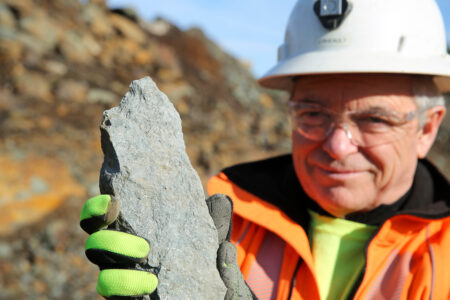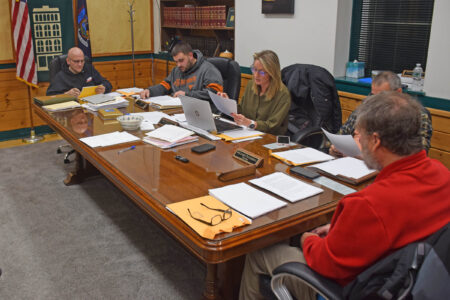What’s the scoop on poop?
Fully funded wastewater plant project planned for next year
- From left, principal engineer Mark Suozzo, chief operator Jason Endries, managing principal Kathy Suozzo and village treasurer Mindy Goddeau stand outside the Lake Placid Wastewater Treatment Plant on Thursday. (Enterprise photo — Grace McIntyre)
- The final clarifier at the Lake Placid Wastewater Treatment Plant, shown on Thursday, is one of the final steps before the water is piped into the Chubb River. (Enterprise photo — Grace McIntyre)
- The aeration basins, which use bacteria to break down organic materials, are shown at the Lake Placid Wastewater Treatment Plant on Thursday. (Enterprise photo — Grace McIntyre)

From left, principal engineer Mark Suozzo, chief operator Jason Endries, managing principal Kathy Suozzo and village treasurer Mindy Goddeau stand outside the Lake Placid Wastewater Treatment Plant on Thursday. (Enterprise photo — Grace McIntyre)
LAKE PLACID — The efforts to update the Lake Placid Wastewater Treatment Plant, which have been in the works since 2022, are going strong. State and federal funding will cover the entire project, which has been a collaborative effort between village employees and contracted engineers.
This project is a comprehensive upgrade of the entire system, especially mechanical parts that just tend to wear down over time, said Jason Endries, the plant’s chief operator. The last upgrade of this type was more than 20 years ago, in 2004. Compare this to a car, for example.
“If you started it in 2004 and started driving it and haven’t stopped yet — that’s pretty much what the wastewater plant is,” Endries said. “You can’t shut it off.”
In light of this challenge, Endries thanks his staff members — Tom VanBenschoten, Carole Macey and Steven LaHart — for their “exceptional” work keeping the plant running.
Mark Suozzo is the principal engineer at the engineering firm, Suozzo, Doty and Associates, that was hired by the village to help with the upgrade project. He credited the village for being proactive with this project, even though the plant is running pretty well. It’s always better to strengthen the system proactively instead of trying to do damage control once something breaks, he said.

The final clarifier at the Lake Placid Wastewater Treatment Plant, shown on Thursday, is one of the final steps before the water is piped into the Chubb River. (Enterprise photo — Grace McIntyre)
“The bones here are good,” Suozzo said. “If you can rehab what’s there, it’s more cost-effective. That’s a much better way to go than building a whole new plant.”
The project is fully funded by grants that will cover the total cost — $12,450,000, with included contingency funds of about $2.9 million, according to village treasurer Mindy Goddeau. These funds include $6.4 million administered by the state Department of Environmental Conservation through the state’s Water Quality Improvement Project program and $1,512,500 from a 2023 Water Infrastructure Improvement Award from the state.
The village also has $1,512,500 in short-term, interest-free hardship financing, which they might not need depending on what the contingency costs end up being, Goddeau said. The last chunk of money comes from an Infrastructure Investment and Jobs Act grant for $3.025 million, which is federal money that has already been granted to the state Environmental Facilities Corporation.
The plant previously had some upgrades done in 2013, mostly involving lab equipment that was harder to find grants to cover, according to Goddeau. The village is still paying off debt from that project.
Even with all of the funding in place, there is still a lot that needs to be done before the village can break ground on the project, which Suozzo said they will aim to do next summer. The designs have to be completed, and reviewed, and then bids have to go out to find a variety of contractors to do the many different types of work required. Goddeau added that the grants add additional levels of approval, where the village needs to demonstrate that the money is being used correctly.

The aeration basins, which use bacteria to break down organic materials, are shown at the Lake Placid Wastewater Treatment Plant on Thursday. (Enterprise photo — Grace McIntyre)
Plus, the logistics of updating an operating plant — without shutting things down and blocking up toilets all around town — are a bit complicated. This plan is also what the Suozzo engineers and Endries are working on now.
–
Everything is connected
–
Treating wastewater might be an out-of-sight, out-of-mind issue for a lot of people. However, the constraints of essential infrastructure, such as wastewater, relate back to everything from tourism to affordable housing. Operating a waste treatment plant in a place like Lake Placid comes with some pretty unique challenges, Endries said.
The population of the village can swing dramatically from 6,000 people during weekdays and off seasons, to up to 40,000 during busier times. This puts a lot of strain on the system, and both extremes present challenges. One part of the treatment process involves a complex ecosystem of “bugs,” different types of bacteria that feed on waste in the water and clean it in the process. During the pandemic, Goddeau said the plant started to run into issues with there not being enough wastewater for the bugs to survive on.
“They have to go from one extreme to the polar opposite extreme,” she said.
“Mindy used the word ‘polar.’ That’s the other thing that the bugs don’t like,” added Kathy Suozzo, the managing principal at the engineering firm.
“It’s cold as hell here,” Endries concluded.
The fluctuating population of the village is also why state grants are so critical, Mark Suozzo said.
“It would just be too much for the local taxpayers to essentially fund a wastewater plant that can handle 10 times the number of people,” he said.
On top of that, environmental standards and requirements are constantly changing. For example, the DEC recently reduced the allowable limits of what can be discharged into the river (referred to as effluent). The levels of phosphorus and ammonia, in particular, are essential for maintaining water quality for wildlife and for humans. Endries expects even stricter limits to be put in place soon.
“That’s why my hair is gray,” he said jokingly while tipping off his hat.
Maintaining and building strong wastewater infrastructure is also essential to addressing another major need in Lake Placid — affordable housing. When new developments are built, the system needs to be prepared for an influx of waste. And adding infrastructure for new developments is not just a matter of tacking new pipes onto the outskirts of the sewage system, Kathy Suozzo said.
“You can say, ‘Oh, we put in all new pipes,'” Goddeau added. “That’s great, but it’s got to run through miles and miles and miles and miles of pipes to get back to the actual plant where it’s being filtered.”
–
Walk through the plant
–
Here’s a quick look at how the plant works.
As the water comes into the system, machines help filter anything that isn’t supposed to be in there — they’ve seen hygiene products, bills and even towels come through, Endries said. The water flows into a set of large, circular concrete tanks called primary clarifiers. To put it simply, these tanks use physical means to separate solids, oil and grease, which rise to the surface of the tank.
The sludge from these clarifiers, along with some other sludge from later parts of the process, feeds the anaerobic digesters. These digesters are kept at a good temperature for bacteria, which consume the waste and produce gasses that are then used to fuel the boilers that keep the digesters at an ideal temperature.
From the primary clarifiers, the water flows into four aeration basins. This is where ecosystems of bacteria help break down organic waste. These bacteria also need oxygen, so the murky water in the basins swirl with tiny bubbles that are fed into the basins by aeration blowers that pump air into the water from below.
After these basins clean the water, it goes to the final clarifiers, which separate and return the sludge to the aeration basins. Finally, the water gets disinfected with UV light.
“The wastewater plant does what nature does, just in concrete tanks, faster and more efficient,” Endries said, in a succinct summary.
At the end of the system of concrete basins and pipes, clear water gushes down a short pipe to the Chubb River. In the river, the water emerges from two openings that have become crusted over with algae and sediment. As if on cue, a fish flits by and a duck lands gracefully on the water. Sometimes, Endries said, the fish try to swim up the effluent and seem to like living around the spot in the river where the water comes out. It’s almost like a silent stamp of approval.
“That’s how clean it is,” he said.





